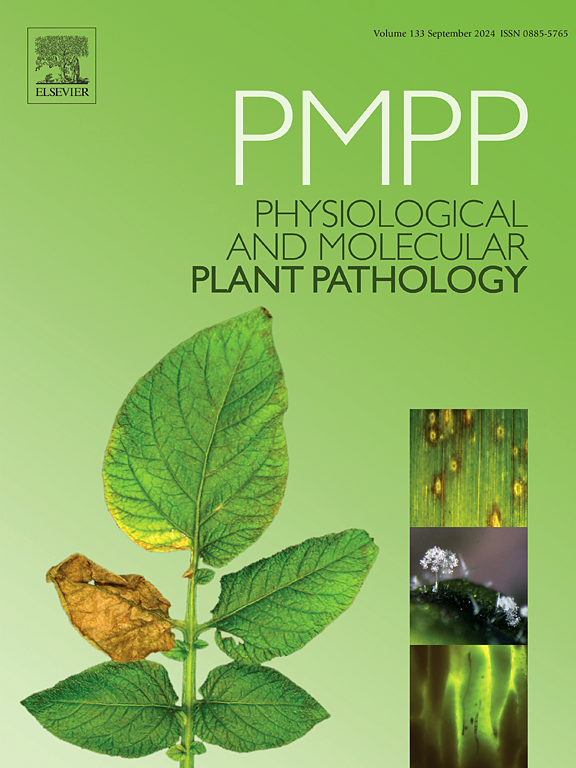Diversity, phylogeny, and pathogenicity of Lasiodiplodia spp. infecting avocado in India and development of sensitive point-of-care LAMP assay for detection of Lasiodiplodia pseudotheobromae
IF 2.8
3区 农林科学
Q2 PLANT SCIENCES
引用次数: 0
Abstract
Avocado (Persea americana) is a vital fruit crop cultivated in the high-humid tropical regions of the Western Ghats, India, which is significantly impacted by diseases caused by Lasiodiplodia species. These opportunistic fungal pathogens, belonging to the Botryosphaeriaceae family, primarily affect woody plants, including avocados. The study aimed to identify the causal agent of graft failure, root rot, stem canker, and dieback in avocado plants. A roving survey was conducted across the Western Ghats in Karnataka, Tamil Nadu, and Kerala to collect symptomatic nursery seedlings and adult plants. Initial identification was performed based on conidial morphology, followed by DNA sequence analysis of the ITS rDNA, translation elongation factor 1-α (tef1-α), and beta-tubulin (β-tub) gene regions. Concatenated analysis of the ITS, tef1-α, and β-tub genes identified ten isolates of Lasiodiplodia pseudotheobromae, two isolates of Lasiodiplodia brasiliensis, and two isolates of Lasiodiplodia iranensis (syn: L. iraniensis). L. pseudotheobromae was recovered from root rot, stem canker, graft failure, and dieback; L. brasiliensis recovered from root rot and stem canker; and L. iranensis was recovered from stem canker samples. Further pathogenicity tests confirmed that these Lasiodiplodia isolates could induce disease in various avocado plant parts, regardless of their tissue of isolation. A loop-mediated isothermal amplification (LAMP) assay was developed for detecting L. pseudotheobromae targeting the tef1-α gene sequence. The comparative testing of LAMP products using a colorimetric dye (hydroxy naphthol blue) confirmed the presence of L. pseudotheobromae in symptomatic samples. This LAMP assay offers superior ease of use, cost-effectiveness, and rapid results for detecting L. pseudotheobromae in symptomatic plants. This study represents the first report of L. pseudotheobromae, L. brasiliensis, and L. iranensis infecting avocados in India.
印度牛油果Lasiodiplodia spp.的多样性、系统发育和致病性以及检测假可可牛油果Lasiodiplodia的敏感点LAMP方法的建立
牛油果(Persea americana)是一种重要的水果作物,种植在印度西高高山脉的高湿热带地区,受到Lasiodiplodia物种引起的疾病的严重影响。这些机会性真菌病原体,属于Botryosphaeriaceae家族,主要影响木本植物,包括鳄梨。该研究旨在确定牛油果植株嫁接失败、根腐病、茎溃烂和枯死的原因。在卡纳塔克邦、泰米尔纳德邦和喀拉拉邦的西高止山脉进行了巡回调查,收集有症状的苗苗和成虫。根据分生孢子形态进行初步鉴定,随后对ITS rDNA、翻译延伸因子1-α (tef1-α)和β-微管蛋白(β-tub)基因区域进行DNA序列分析。通过ITS、tef1-α和β-tub基因的连接分析,鉴定出10株假可可Lasiodiplodia pseudotheobromae、2株brasiliensis和2株伊朗Lasiodiplodia iranensis(同步:L. iraniensis)。假可可树从根腐病、茎溃烂、嫁接失败和枯死中恢复;巴西松根腐病和茎溃疡病的恢复;从茎溃疡病样品中分离到伊朗乳杆菌。进一步的致病性试验证实,这些分离的Lasiodiplodia菌株可以在牛油果植株的各个部位致病,而与分离的组织无关。建立了以tef1-α基因序列为靶点的假可可乳酸菌环介导等温扩增(LAMP)检测方法。使用比色染料(羟基萘酚蓝)对LAMP产品进行比较测试,证实在有症状的样品中存在假可可碱乳杆菌。这种LAMP检测提供了优越的易用性,成本效益和快速的结果,用于检测有症状植物中的假可可碱L.。本研究是印度首次报道假可可乳杆菌、巴西乳杆菌和伊朗乳杆菌侵染牛油果。
本文章由计算机程序翻译,如有差异,请以英文原文为准。
求助全文
约1分钟内获得全文
求助全文
来源期刊
CiteScore
4.30
自引率
7.40%
发文量
130
审稿时长
38 days
期刊介绍:
Physiological and Molecular Plant Pathology provides an International forum for original research papers, reviews, and commentaries on all aspects of the molecular biology, biochemistry, physiology, histology and cytology, genetics and evolution of plant-microbe interactions.
Papers on all kinds of infective pathogen, including viruses, prokaryotes, fungi, and nematodes, as well as mutualistic organisms such as Rhizobium and mycorrhyzal fungi, are acceptable as long as they have a bearing on the interaction between pathogen and plant.

 求助内容:
求助内容: 应助结果提醒方式:
应助结果提醒方式:


